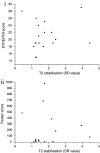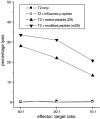The use of reverse immunology to identify HLA-A2 binding epitopes in Tie-2
- PMID: 16408213
- PMCID: PMC11029822
- DOI: 10.1007/s00262-005-0119-1
The use of reverse immunology to identify HLA-A2 binding epitopes in Tie-2
Abstract
A potential target for a cancer vaccine would be receptors, such as Tie-2 which are over expressed on tumour endothelium. Using computer aided motif predictions for possible HLA class I epitopes, we have identified peptides from Tie-2 that should bind with a range of affinities to HLA-A*0201. No direct correlation between predicted values and actual binding affinities was observed. Although, the programs did produce a number of false positives, two epitopes were predicted that bound with relatively high affinity when compared with an influenza peptide. We have previously identified a Tie-2 epitope and shown that it was only immunogenic when we substituted preferred amino acids at key anchor residues to increase binding affinity. In this study we used a similar approach to generate modified epitopes. When HLA-A2 transgenic mice were immunised with peptides, CTL killing of the target cells was only achieved when the wild type epitope was presented at moderate levels. Moreover, the efficiency of immunisation was increased when we linked CD4 epitopes to CD8 epitopes. Caution should therefore be employed in the use of both reverse immunology and anchor modification of CTL epitopes in the identification of CTL epitopes for cancer vaccines.
Figures



Similar articles
-
Identification of an HLA-A*0201 cytotoxic T lymphocyte epitope specific to the endothelial antigen Tie-2.Int J Cancer. 2004 Jun 10;110(2):245-50. doi: 10.1002/ijc.20120. Int J Cancer. 2004. PMID: 15069689
-
Identification and enhancement of HLA-A2.1-restricted CTL epitopes in a new human cancer antigen-POTE.PLoS One. 2013 Jun 4;8(6):e64365. doi: 10.1371/journal.pone.0064365. Print 2013. PLoS One. 2013. PMID: 23750208 Free PMC article.
-
A novel HLA-A2-restricted CTL epitope of tumor-associated antigen L6 can inhibit tumor growth in vivo.J Immunother. 2012 Apr;35(3):235-44. doi: 10.1097/CJI.0b013e318248f2ae. J Immunother. 2012. PMID: 22421941
-
Identification of HLA-A*0201-restricted CTL Epitopes for MLAA-34-specific Immunotherapy for Acute Monocytic Leukemia.J Immunother. 2021 May 1;44(4):141-150. doi: 10.1097/CJI.0000000000000350. J Immunother. 2021. PMID: 33596023
-
HLA-A2-restricted CTL epitopes of a novel lung cancer-associated cancer testis antigen, cell division cycle associated 1, can induce tumor-reactive CTL.Int J Cancer. 2008 Dec 1;123(11):2616-25. doi: 10.1002/ijc.23823. Int J Cancer. 2008. PMID: 18770861
References
-
- Beattie T, JKaul R, Rostron T, Dong T, Easterbrook P, Jaoko W, Kimani J, Plummer F, McMichael A, Rowaland-Jones S. Screening for HIV-specific T-cell responses using overlapping 15-mer peptide pools or optimized epitopes. AIDS. 2004;18:1595–1598. doi: 10.1097/01.aids.0000131362.82951.b2. - DOI - PubMed
MeSH terms
Substances
LinkOut - more resources
Full Text Sources
Other Literature Sources
Research Materials
Miscellaneous

